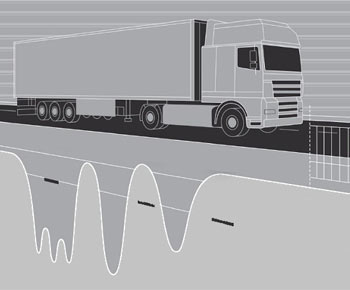

MPC |
| Title: | Sensitivity and Accuracy Assessment of Vehicle Weigh-in-Motion System Measurement Errors Using In-Pavement Strain-Based Sensors |
| Principal Investigators: | Pan Lu and Denver Tolliver |
| University: | North Dakota State University |
| Status: | Completed |
| Year: | 2019 |
| Grant #: | 69A3551747108 (FAST Act) |
| Project #: | MPC-601 |
| RiP #: | 01704399 |
| RH Display ID: | 151209 |
| Keywords: | accuracy, data collection, humidity, sensitivity analysis, sensors, strain (mechanics), temperature, vehicle dynamics, weigh in motion, wind |
 Measuring the weights of passing vehicles at highway speed is an important activity of any intelligent transportation system. Wight-in-motion (WIM) technology has various application in highway management, infrastructure investment optimization, law enforcement, and pavement design. The measurement accuracy of a WIM is critically important for some WIM applications such as law enforcement, highway capacity analysis, and pavement design ect. Different from previous work, our study focuses on understanding the relationship between the accuracy of an in-pavement strain-sensor based WIM system and its external contributors such as humidity, temperature, wander behavior and wind speed, which the authors found unclear from literature search. Such research is very important for WIM quality assurance application successes. Since the accuracy of WIM data is highly dependent on many factors, such as temperature, vehicle speeds, precipitation, cross wind speeds, and the evenness of the road surface. In general there are about 0.97% anomalies in vehicle class and 6.42% anomalies in vehicle weight. With that error, a WIM system can underestimate about 90% of truck weights and the degree of underestimation can exceed 50% of the corresponding static weights. The objective of this study is to provide scientific evidences of the systematic sensitivity analysis on the influences of external contributors on the measurement accuracy of a WIM system based on in-pavement strain sensors. The main external contributors to be investigated in this study include air temperature, vehicle wander behavior, air humidity, and wind speed on the measurement accuracy of a WIM system.
Measuring the weights of passing vehicles at highway speed is an important activity of any intelligent transportation system. Wight-in-motion (WIM) technology has various application in highway management, infrastructure investment optimization, law enforcement, and pavement design. The measurement accuracy of a WIM is critically important for some WIM applications such as law enforcement, highway capacity analysis, and pavement design ect. Different from previous work, our study focuses on understanding the relationship between the accuracy of an in-pavement strain-sensor based WIM system and its external contributors such as humidity, temperature, wander behavior and wind speed, which the authors found unclear from literature search. Such research is very important for WIM quality assurance application successes. Since the accuracy of WIM data is highly dependent on many factors, such as temperature, vehicle speeds, precipitation, cross wind speeds, and the evenness of the road surface. In general there are about 0.97% anomalies in vehicle class and 6.42% anomalies in vehicle weight. With that error, a WIM system can underestimate about 90% of truck weights and the degree of underestimation can exceed 50% of the corresponding static weights. The objective of this study is to provide scientific evidences of the systematic sensitivity analysis on the influences of external contributors on the measurement accuracy of a WIM system based on in-pavement strain sensors. The main external contributors to be investigated in this study include air temperature, vehicle wander behavior, air humidity, and wind speed on the measurement accuracy of a WIM system.
Note to project PIs: please use the Track Changes feature when editing the above Word file(s). Updated document(s) should be emailed to ndsu.ugpti@ndsu.edu.